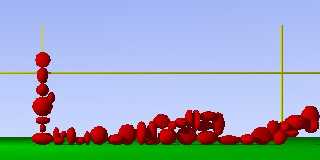|
 |
I'm working on a macro that will hopefully eventually generate a dry-stone wall,
but I'm running into problems. In the image below, the wall should approx. fill
the area marked out by the yellow cylinders, but it ain't.
If anyone can be bothered to:
a) work out what I'm trying to do
b) work out how I'm trying to do it
and
c) what's going wrong
then here is the code:
//start code
#version 3.5;
#include "colors.inc"
global_settings {
assumed_gamma 1.0
}
// ----------------------------------------
camera {
location <0.0, 1.5, -100.0>
look_at <0.0, 1.5, 0.0>
}
light_source {
<0, 0, 0> // light's position (translated below)
color rgb <1, 1, 1> // light's color
translate <-30, 30, -30>
}
// ----------------------------------------
#macro BuildWall()
#declare Rand1 = seed(142);
#declare Brick = sphere{0,1 pigment{Red}}
#declare Ground = plane{y,0 pigment{Green}}
#declare WallLen = 50;
#declare WallHi = 15;
#declare ThisLen = 0;
#declare ThisHi = 0;
#declare Wall = object{Ground}
#while(ThisLen <= WallLen & ThisHi <= WallHi)
#declare XScale = rand(Rand1)*2 + 0.5;
#declare YScale = rand(Rand1)*2 + 0.5;
#declare ZScale = rand(Rand1)*2 + 0.5;
#declare ThisBrick = object{Brick scale<XScale, YScale, ZScale>}
#if(ThisLen = 0)
#declare Norm = <0, 0, 0>;
#declare Start = <0,WallHi*2,0>;
#declare InterA = trace ( Wall, Start, <0, -1, 0>, Norm );
#declare Wall = union{
object{Wall}
object{ThisBrick translate y*(InterA.y + YScale)}
}
#declare ThisLen = XScale;
#declare ThisHi = InterA.y + YScale;
#else
#declare Norm = <0, 0, 0>;
#declare Start = <ThisLen+XScale,WallHi*2,0>;
#declare InterA = trace ( Wall, Start, <0, -1, 0>, Norm );
#if(InterA.y < ThisHi)
#declare Norm = <0, 0, 0>;
#declare Start = <WallLen*2,InterA.y + YScale,0>;
#declare InterB = trace ( Wall, Start, <-1, 0, 0>, Norm );
#declare Wall = union{
object{Wall}
object{ThisBrick translate<InterB.x + XScale, InterA.y + YScale, 0>}
}
#end
#declare ThisLen = InterB.x + (XScale*2);
#declare ThisHi = InterA.y + YScale;
#if(ThisLen > WallLen & ThisHi <= WallHi)
#declare ThisLen = 0;
#end
#end
#end
#end
BuildWall()
object{Wall}
cylinder{0,y*25, 0.2 pigment{Yellow}}
cylinder{0,y*25, 0.2 pigment{Yellow} translate x*50}
cylinder{x*-10,x*60, 0.2 pigment{Yellow} translate y*15}
//end code
... and here is the image
--
#macro G(D,E,F)#local I=array[3]{D,E,F}#local B=0;triangle{#while(
B<3)#while(I[B])A[mod(I[B],10)]+#local I[B]=div(I[B],10);#end<-5,-
2,9>#local B=B+1;#end}#end #local A=array[7]{x,x*2,x*4,y,y*2,y*4,z
}light_source{-x*6-z*9,1}mesh{G(105,10,146)G(105,246,10)G(105,56,
146)G(105,1256,246)G(1256,126,220)G(22156,2216,201)pigment{rgb 1}}//TM
Post a reply to this message
Attachments:
Download 'dw1.jpg' (13 KB)
Preview of image 'dw1.jpg'

|
 |




![]()